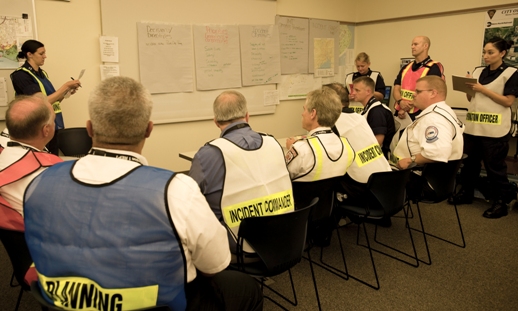Return to Q-Directorate's Home Page.

BRIDGEPORT, Conn. — Coast Guard personnel participate in an Area Maritime Security Training and Exercise Program on June 13, 2013. The exercise allows Coast Guard members to collaborate with local, state, and government agencies to understand the role each plays during incident response. U.S. Coast Guard photo by Petty Officer 3rd Class Ali Flockerzi
Positions in Emergency Management & Incident Response
Within emergency management (EM), the Auxiliary appointed officer positions such as District Staff Officer for Emergency Management (DSO-EM) and Assistant District Staff Officers for Emergency Management (ADSO-EM)support specific programs at the District level.
The Emergency Management and Disaster Response Directorate, known as the Q-Directorate, operates at the National Staff level. The Q-Directorate issues national policy directives for emergency management functions and,when requested, supports Auxiliary District emergency response operations.
Staff officer positions are available at the national level within the Q-Directorate. Some of these positions do not require specific EM experience or advanced qualifications. For an Auxiliary member interested in pursuing an EM career path, a staff position offers an opportunity to gain experience while supporting the mission.
Incident Command System Positions
The Agency Representative (AREP) is an essential position in the Incident Command System (ICS). During a significant incident, the AREP staffs the Emergency Operation Center (EOC) or an off-site remote location as the Coast Guard Sector’s representative.
An EOC Incident Commander (IC) may be tasked with coordinating Coast Guard boat or helicopter support if needed. This type of request is submitted through the local ARep, who communicates with the Coast Guard Sector’s Incident Management Team (IMT) and provides feedback to the EOC regarding the capability to fulfill the resource request.
A Coast Guard Sector IMT may request information from the local area of operation, such as the status of bridge openings from the county. The AREP facilitates these communications.
ICS positions are filled by individuals responsible for managing incident response, including command staff, general staff, and unit leaders. The Incident Command System features a comprehensive, hierarchical command structure, with an Incident Commander leading task coordination for the response. In situations that are large and complex, an Area Commander may be appointed to provide assistance.
Many, but not all, ICS positions require sign-offs of Personal Qualification Standards (PQS). Some advanced ICS positions require a PQS sign-off and a Letter of Designation from the Coast Guard Command.Additional information about Incident Command System positions may be found HERE .